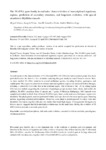The 5S rDNA gene family in mollusks: characterization of transcriptional regulatory regions, prediction of secondary structures, and long-term evolution, with special attention to Mytilidae mussels

Use this link to cite
http://hdl.handle.net/2183/19215Collections
- Investigación (FCIE) [1228]
Metadata
Show full item recordTitle
The 5S rDNA gene family in mollusks: characterization of transcriptional regulatory regions, prediction of secondary structures, and long-term evolution, with special attention to Mytilidae musselsDate
2011-07-01Citation
Miguel Vizoso, Joaquín Vierna, Ana M. González-Tizón, Andrés Martínez-Lage; The 5S rDNA gene family in mollusks: characterization of transcriptional regulatory regions, prediction of secondary structures, and long-term evolution, with special attention to Mytilidae mussels. J Hered 2011; 102 (4): 433-447
Abstract
[Abstract] Several reports on the characterization of 5S ribosomal DNA (5S rDNA) in various animal groups have been published to date, but there is a lack of studies analyzing this gene family in a much broader context. Here, we have studied 5S rDNA variation in several molluskan species, including bivalves, gastropods, and cephalopods. The degree of conservation of transcriptional regulatory regions was analyzed in these lineages, revealing a conserved TATA-like box in the upstream region. The evolution of the 120 bp coding region (5S) was also studied, suggesting the occurrence of paralogue groups in razor clams, clams, and cockles. In addition, 5S rDNA sequences from 11 species and 7 genus of Mytilidae Rafinesque, 1815 mussels were sampled and studied in detail. Four different 5S rDNA types, based on the nontranscribed spacer region were identified. The phylogenetic analyses performed within each type showed a between-species gene clustering pattern, suggesting ancestral polymorphism. Moreover, some putative pseudogenized 5S copies were also identified. Our report, together with previous studies that found high degree of intragenomic divergence in bivalve species, suggests that birth-and-death evolution may be the main force driving the evolution of 5S rDNA in these animals, even at the genus level.
Keywords
Ancestral polymorphism
Birth-and-death evolution
Concerted evolution
Mollusks
Pseudogenes
5S ribosomal RNA
Birth-and-death evolution
Concerted evolution
Mollusks
Pseudogenes
5S ribosomal RNA
Editor version
Rights
This is a pre-copyedited, author-produced version of an article accepted for publication in Journal of Heredity following peer review. The version of record: Miguel Vizoso, Joaquín Vierna, Ana M. González-Tizón, Andrés Martínez-Lage; The 5S rDNA gene family in mollusks: characterization of transcriptional regulatory regions, prediction of secondary structures, and long-term evolution, with special attention to Mytilidae mussels. J Hered 2011; 102 (4): 433-447, is available online at: https://doi.org/10.1093/jhered/esr046.
ISSN
0022-1503
1465-7333
1465-7333





